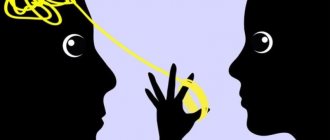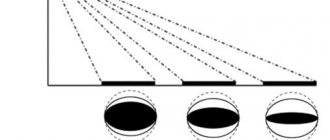Every day, every person is bombarded with a huge amount of information. We encounter new situations, objects, phenomena. Some people cope with this flow of knowledge without problems and successfully use it to their advantage. Others have difficulty remembering anything. This situation is largely explained by a person’s belonging to a certain type in terms of the way they perceive information. If it is served in a form that is inconvenient for humans, then its processing will be extremely difficult.
What is information?
The concept of “information” has an abstract meaning and its definition largely depends on the context. Translated from Latin, this word means “clarification”, “presentation”, “familiarization”. Most often, the term “information” refers to new facts that are perceived and understood by a person, and also found useful. In the process of processing this information received for the first time, people gain certain knowledge.
Diagnostics
If the above deviations develop, you should consult a doctor, who, in turn, will try to identify the full picture of the disease and study the medical history. For example, if a patient has recently suffered a brain tumor, stroke or other various injuries, this can become a significant basis for the formation of these disorders. Therefore, the attending physician must take into account all the nuances in the process of diagnosing disorders, and then refer to specialized specialists to check the condition of vision and hearing. Also, in the process of checking for tactile-motor perception disorders, various laboratory tests are performed.
How is information received?
The perception of information by a person is an acquaintance with phenomena and objects through their impact on various senses. By analyzing the result of the impact of a particular object or situation on the organs of vision, hearing, smell, taste and touch, the individual receives a certain idea about them. Thus, the basis in the process of perceiving information is our five senses. In this case, a person’s past experience and previously acquired knowledge are actively involved. By referring to them, you can attribute the information received to already known phenomena or separate them from the general mass into a separate category. Methods of perceiving information are based on some processes associated with the human psyche:
- thinking (having seen or heard an object or phenomenon, a person, starting to think, realizes what he is faced with);
- speech (the ability to name the object of perception);
- feelings (various types of reactions to objects of perception);
- will (a person’s ability to organize the process of perception).
Presentation of information
According to this parameter, information can be divided into the following types:
- Text. It is represented in the form of all kinds of symbols, which, when combined with each other, make it possible to obtain words, phrases, sentences in any language.
- Numeric. This is information represented by numbers and signs that express a certain mathematical operation.
- Sound. This is directly oral speech, thanks to which information from one person is transmitted to another, and various audio recordings.
- Graphic. It includes diagrams, graphs, drawings and other images.
Perception and presentation of information are inextricably linked. Each person tries to choose exactly the option for presenting data that will ensure the best understanding of it.
Treatment
Once the cause of the tactile perception disorder has been determined and all efforts have been directed towards treating and eliminating the underlying pathology, psychotherapeutic therapy and consultations with a speech therapist and neuropsychologist should be carried out in parallel. Treatment can last for many years or give good results in the first two weeks; this is a purely individual aspect. As a rule, treatment of these disorders begins after adequate measures have been taken to eliminate the patient's underlying disease. There are cases when, after complete recovery from the underlying disease, impaired functions were restored without the use of additional corrective measures.
Ways of human perception of information
A person has several such methods at his disposal. They are determined by the five senses: vision, hearing, touch, taste and smell. In this regard, there is a certain classification of information according to the method of perception:
- visual;
- sound;
- tactile;
- taste;
- olfactory.
Visual information is perceived through the eyes. Thanks to them, various visual images enter the human brain, which are then processed there. Hearing is necessary for the perception of information coming in the form of sounds (speech, noise, music, signals). The organs of touch are responsible for the ability to perceive tactile information. Receptors located on the skin make it possible to estimate the temperature of the object under study, the type of its surface, and shape. Taste information enters the brain from receptors on the tongue and is converted into a signal by which a person understands what product it is: sour, sweet, bitter or salty. The sense of smell also helps us understand the world around us, allowing us to distinguish and identify all kinds of smells. Vision plays the main role in the perception of information. It accounts for about 90% of the knowledge gained. The sound way of perceiving information (radio broadcast, for example) makes up about 9%, and the other senses are responsible for only 1%.
Prevention
The above-mentioned disorders of tactile perception do not have specific methods of prevention, but you can protect yourself from this with the help of the right lifestyle.
To avoid such disorders that negatively affect tactile-motor perception, experts advise the following:
- first of all, give up bad and destructive habits;
- keep a daily routine;
- find a hobby and do what you love as often as possible;
- get enough sleep;
- communicate more with loved ones and friends;
- dream and make plans.
Such simple, at first glance, tips will help you live a full life, where there will be no room for the world of illusions.
Types of perception
The same information, obtained in any particular way, is perceived differently by each person. Someone, after reading one of the pages of a book for a minute, can easily retell its contents, while others will remember practically nothing. But if such a person reads the same text out loud, he will easily reproduce in his memory what he heard. Such differences determine the characteristics of people’s perception of information, each of which is inherent in a certain type. There are four in total:
- Visuals.
- Auditory learners.
- Kinesthetics.
- Discrete.
It is often very important to know what type of information perception is dominant for a person and how it is characterized. This significantly improves mutual understanding between people and makes it possible to convey the necessary information to your interlocutor as quickly and completely as possible.
Visuals
These are people for whom vision is the main sense organ in the process of learning about the world around them and perceiving information. They remember new material well if they see it in the form of text, pictures, diagrams and graphs. In the speech of visual learners, there are often words that are in one way or another connected with the characteristics of objects by their external features, the function of vision itself (“let’s see”, “light”, “bright”, “will be visible”, “it seems to me”). Such people usually speak loudly, quickly, and gesticulate actively. Visual people pay great attention to their appearance and surrounding environment.
Causes of hallucinations
Scientists have not yet identified specific factors that may influence the occurrence of hallucinations. The reasons remain completely unexplored, but there are still assumptions:
- alcohol and drug intoxication can cause significant damage not only to physical but also mental health;
- disruption of brain function;
- tactile hallucinations may be caused by schizophrenia or encephalitis;
- side effects of drug treatment;
- disturbance of the senses;
- Experts have identified another factor called “mass psychosis” - this happens when an absolutely healthy person is susceptible to mass suggestion.
Audials
For auditory learners, it is much easier to learn something that they have heard once, rather than seen a hundred times. The peculiarities of such people’s perception of information lie in their ability to listen and remember well what is said, both in a conversation with colleagues or relatives, and at a lecture at an institute or at a work seminar. Auditory learners have a large vocabulary and are pleasant to communicate with. Such people know how to perfectly convince their interlocutor in a conversation with him. They prefer quiet activities to active pastimes; they like to listen to music.
Discrete
The ways of perceiving information are directly related to the human senses. The majority of people gain knowledge through sight, hearing, touch, smell and taste. However, types of information perception include those that are primarily associated with thinking. People who perceive the world around them in this way are called discretes. There are quite a few of them, and they are found only among adults, since logic is not sufficiently developed in children. At a young age, the main ways of perceiving discrete information are visual and auditory. And only with age do they begin to actively think about what they saw and heard, while discovering new knowledge for themselves.
Getting rid of illusions
The first step towards recovery will be to identify the underlying disease, since illusions can be a side sign of a more serious illness. To do this, first of all you need to contact a therapist. With the help of medical tests and examination, the doctor will be able to make a diagnosis and, if necessary, refer you to a specialized specialist. For example, if the cause of illusions is symptoms of syphilis, the patient will be referred to a venereologist. In this case, it is worth paying attention to the underlying disease and starting treatment with it. After she retreats, the tactile illusions will pass.
But it happens that this disorder is also mental in nature. In this case, you should contact a psychotherapist or psychiatrist. They will help make or refute the diagnosis of schizophrenia or bipolar disorder. If a specialist identifies a specific diagnosis, he will be able to help with medication and specific therapy. In this area, the approach to each patient is purely individual, therefore self-medication is strictly prohibited. Medicines and recipes read on various forums on the Internet or suggested by friends can only worsen the situation.
If illusions occur in children before or after bedtime, you should see a specialist and, if necessary, undergo treatment. A psychiatrist or psychotherapist, having worked with the child and his parents, will be able to identify the root cause of this disorder, after which several sessions of psychotherapy will follow, which should subsequently help the child cope with a false perception of the real world.
Type of perception and learning ability
The ways people perceive information largely determine the form of learning that will be most effective for them. Of course, there are no people who would receive new knowledge entirely with the help of one sense organ or a group of them, for example, touch and smell. All of them act as means of perceiving information. However, knowing which sense organs are dominant in a particular person allows others to quickly convey the necessary information to him, and allows the person himself to effectively organize the process of self-education.
Visual learners, for example, need to present all new information in a readable form, in pictures and diagrams. In this case, they remember it much better. Visual people usually excel in the exact sciences. Even in childhood, they are excellent at putting together puzzles, know many geometric shapes, are good at drawing, sketching, and building with cubes or construction sets.
Auditory learners, on the contrary, more easily perceive information received from oral speech. This could be a conversation with someone, a lecture, an audio recording. When teaching a foreign language for auditory learners, audio courses are preferable to a printed tutorial. If you still need to remember the written text, it is better to speak it out loud.
Kinesthetic learners are very mobile. They find it difficult to concentrate on anything for long periods of time. Such people find it difficult to learn material learned at a lecture or from a textbook. The memorization process will go faster if kinesthetic learners learn to connect theory and practice. It is easier for them to learn sciences such as physics, chemistry, biology, in which a specific scientific term or law can be represented as the result of an experiment carried out in a laboratory.
Discrete people take a little longer than other people to take new information into account. They must first comprehend it and relate it to their past experience. Such people can, for example, record a teacher’s lecture on a dictaphone and subsequently listen to it a second time. Among the discretes there are many people of science, since rationality and logic are above all else for them. Therefore, in the process of studying, they will be closest to those subjects in which accuracy determines the perception of information - computer science, for example.
Forecast
If the above violations are detected, correction of tactile perception is necessary. Neglecting treatment in this case is not advisable. Various kinds of hallucinations, agnosia, autotopagnosia are progressive diseases that will only worsen a person’s condition. In this case, the prognosis will be disappointing, since the patient is unable to distinguish the real from the imaginary.
In the absence of appropriate treatment, these disorders will only progress, and the person himself will become even more distant from reality, plunging into his own world. In such situations, you should not self-medicate and look for answers to your questions on your own.
Role in communication
The types of information perception also influence how best to communicate with a person so that he listens to you. For visual learners, the appearance of the interlocutor is very important. The slightest carelessness in clothing can turn him off, after which it will not matter at all what he says. When talking with a visual person, you need to pay attention to your facial expressions, speak quickly using gestures, and support the conversation with schematic drawings.
In a conversation with an auditory learner, there should be words that are close to him (“listen to me”, “sounds tempting”, “this says a lot”). The perception of information by an auditory person depends largely on how the interlocutor speaks. The timbre of the voice should be calm and pleasant. It is better to postpone an important conversation with an auditory person if you have a severe cold. Such people also cannot tolerate shrill notes in their voices.
Negotiations with a kinesthetic person should be carried out in a room with a comfortable air temperature and a pleasant smell. Such people sometimes need to touch the interlocutor, so they better understand what they heard or saw. You shouldn’t expect a kinesthetic learner to make a quick decision immediately after the conversation. He needs time to listen to his feelings and understand that he is doing everything right.
Dialogue with discrete people must be built on the principle of rationality. It is best to operate with strict scientific facts and rules. For discrete data, the language of numbers is more understandable.











